Visit our Bread Recipes page for more fantastic homemade breads!
Bread with soup. Bread for toast. Bread to sop up the last streaks of sauce or gravy or pan juices. I suppose you might be able to survive without bread, but you sure can’t live without it. A big, fat, puffy, chewy, golden loaf of homemade bread is just about the best thing that could possibly happen to your day.
This is not one-hour or no-knead, but is so worth your time. This is another one of those foods that make you want to gnaw off your own foot while it’s cooking; It smells so good that you just can’t help yourself. When you tear a hot corner from this loaf and watch a cold pat of salted butter melt down into the soft crumb you’ll go weak in the knees. Assuming you haven’t eaten past your knees, that is…
Fresh from the oven and ripped into hunks, this bread is exactly what you want to sop up soups, sauces, dressings, gravies and pan juices. If you are a patient, forbearing, big-picture type person and you let it cool completely, this slices beautifully for sandwiches or toast.
This is The Minions’ favorite bread. They like that it yields two mega-sized loaves. They love that I top one with just sesame seeds and the other with sesame seeds, poppy seeds, onion flakes, and garlic flakes. They live for the times I tell them they can tear off industrial sized pieces from the loaf that’s dressed like an everything bagel. Butter is applied liberally. There are animal noises. Crumbs fly. They wait, slightly more patiently, for the sesame loaf to cool. They slice quarter-inch thick pieces of bread and like them toasted on one side with a top-hat of blueberry jam.
On the nights that I make them wait, they mill around the kitchen aimlessly, standing silently behind me like little ghosts waiting… waiting… waiting… making their way to the table and half-heartedly helping themselves to the whatever-else-I’m-serving then pouncing when the bread basket gets to them.
This is a bread of beauty; golden brown, crispy crust topped with crunchy seeds (and perhaps spices) and a soft, yielding interior. It is another gem of a recipe from the King Arthur Flour Company and their top notch baker’s test kitchen.
I’ve been making this bread for somewhere near ten years- ever since this recipe appeared printed in the pages of their horribly tempting catalogue. It’s a hard recipe to mess up beyond edibility. I’ve accidentally left the dough to rise overnight. I’ve hurried it along and forgotten the second rise.
I’ve brushed and topped it with exactly nothing at all. I’ve substituted bread flour for all-purpose flour out of necessity. And every single time it’s wonderful.
It’s a very forgiving bread to make if you’re nervous about working with yeast or dough, as I have accidentally proven time and again.
Here’s a comforting bit of knowledge about yeast. If you don’t have a warm place to let the dough rise, don’t worry! It will still rise, it’ll just take longer.
Sometimes much longer. Just be sure to keep it lightly covered to prevent the surface of the dough from drying. Do you want to see how very easy the whole process is? Watch this quick video!
Please try this. Pretty please. With sesame seeds on top.
Sesame Semolina Bread
Gently adapted from King Arthur Flour Baker’s Catalogue.
Scroll to the bottom for an easy-print version of this recipe!
To Shape the Dough:
Turn the dough out onto a clean surface and form into a neat mass. Divide the dough in half, then divide each half into 3 pieces. Cover three of the pieces with a towel while working with the other three.
Pat one piece into a rough oval. Use the side of your hand to press an indentation along the length of the dough piece.
Fold the dough together along the length of the indentation.
Roll lightly with the hands to form a thick rope between 12 and 14 inches long. Repeat with the other two pieces so that you have 3 ropes of roughly equal length. Line them up in parallel with the ends facing you.
To Braid the Dough:
Gently grasp the end of the rope on the far left. Lift it to about the center, leaving the far end on the counter, cross it over the rope nearest to it and lay it down. Now grasp the end of the piece on the far right and lift it to about the center, leaving its far end on the counter, cross it over the (now) center rope (which is the first one you moved) and lay it down.
This is the manoeuver you will repeat – far left over center, far right over center, and so on- until you have ends too short to continue. At that point, pinch the ends together and tuck under the braid. Now go back to the center of the loaf and finish braiding the loaf toward the top. When you reach the ends, pinch together and tuck under.
The whole process looks like this:
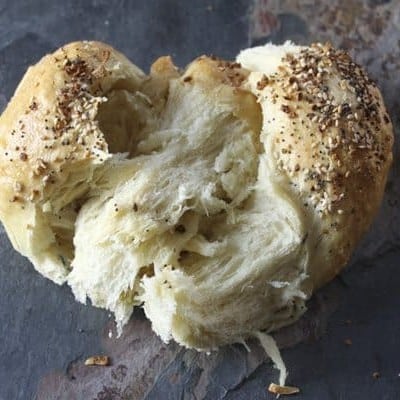
Braided Semolina Bread
Rate RecipeIngredients
- 4 cups all-purpose flour 1 pound, 1 ounce, by weight
- 2 cups semolina flour 11 1/2 ounces, by weight
- 3 teaspoons SAF or instant yeast
- 3 teaspoons kosher salt
- 4 tablespoons sugar or non-diastatic malt powder
- 4 tablespoons extra virgin olive oil
- 2 cups lukewarm water 16 ounces, by weight or volume
- 1 beaten egg
- Optional Toppings:
- Sesame seeds
- Poppy seeds
- Onion flakes dehydrated
- Garlic flakes dehydrated
- Coarse salt
Instructions
To Mix Dough By Hand:
- Add all ingredients except the egg and toppings to a large mixing bowl and stir together with a sturdy wooden spoon until you form a shaggy but cohesive dough. Let the dough rest for 30 minutes, covered with a clean towel. Turn out onto a lightly floured counter top and knead until smooth and elastic, about 10 minutes. Transfer dough to a clean bowl, cover with a damp towel and let rise in a warm, draft-free place until doubled in size, about 2 hours.
- !To Mix Dough By Stand Mixer:
- Add all ingredients except the egg and toppings to the work bowl of your stand mixer fitted with the dough hook. Turn mixer onto the lowest setting and mix until a shiny, elastic dough forms. Remove the bowl from the mixer, cover the bowl with a damp towel and let rise in a warm, draft-free place until doubled in size, about 2 hours.
- !To Mix Dough By Bread Machine:
- Add all ingredients except the egg and toppings to the pan of your bread machine that has been fitted with the dough paddle(s). Set the bread machine on the dough setting and press start. When the cycle is completed, proceed with shaping...
- !To Shape the Dough:
- Turn the dough out onto a clean surface and form into a neat mass. Divide the dough in half, then divide each half into 3 pieces. Cover three of the pieces with a towel while working with the other three.
- Pat one piece into a rough oval. Use the side of your hand to press an indentation along the length of the dough piece. Fold the dough together along the length of the indentation and roll lightly with the hands to form a thick rope between 12 and 14 inches long. Repeat with the other two pieces so that you have 3 ropes of roughly equal length. Line them up in parallel with the ends facing you.
- !To Braid the Dough:
- Either line a half sheet pan with parchment or set a baking stone out to use.
- Gently grasp the end of the rope on the far left. Lift it to about the center, leaving the far end on the counter, cross it over the rope nearest to it and lay it down. Now grasp the end of the piece on the far right and lift it to about the center, leaving its far end on the counter, cross it over the (now) center rope (which is the first one you moved) and lay it down. This is the manoeuver you will repeat - far left over center, far right over center, and so on- until you have ends too short to continue. At that point, pinch the ends together and tuck under the braid. Now go back to the center of the loaf and finish braiding the loaf toward the top. When you reach the ends, pinch together and tuck under. Transfer the braid to the parchment lined sheet or the baking stone. Cover the loaf lightly and let rise in a warm place until puffy in appearance and about doubled in size.
- Preheat oven to 400°F. Whisk the egg until very loose. Paint generously onto the risen bread braids and sprinkle the braids with desired toppings.
- Bake for 18-26 minutes or until your preferred shade of golden to deep brown and firm on top. Turn the oven off, prop the door open a little (two inches, if you can make your door behave) and let cool for at least an hour. Or tear into the loaves with your teeth. I won't tell.
Nutrition
Nutritional information is an estimate and provided to you as a courtesy. You should calculate the nutritional information with the actual ingredients used in your recipe using your preferred nutrition calculator.
did you make this recipe?
Make sure to tag @foodiewithfam on Instagram and #hashtag it #foodiewithfamily so I can check it out!
This post was first published March 4, 2011.
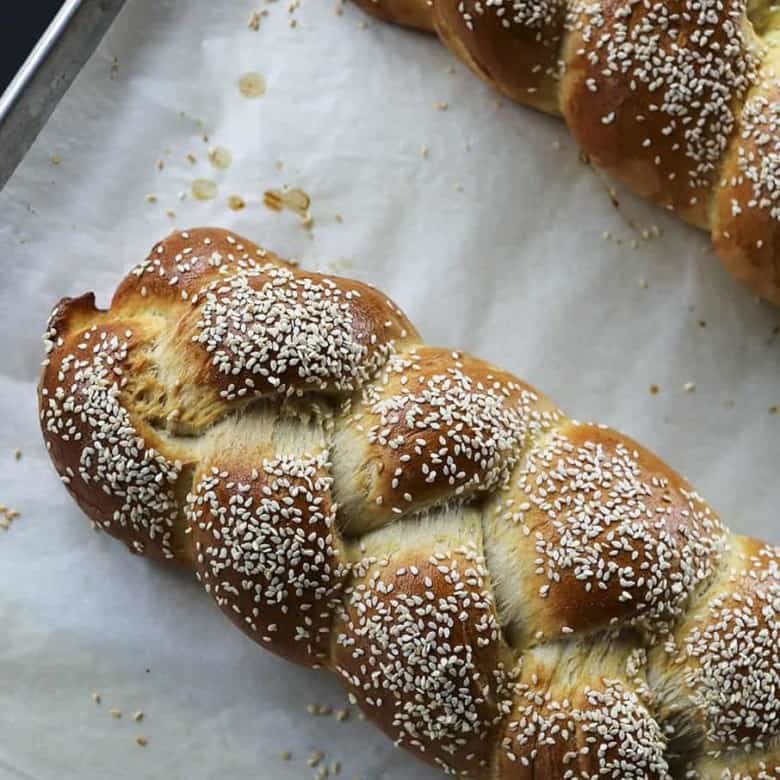
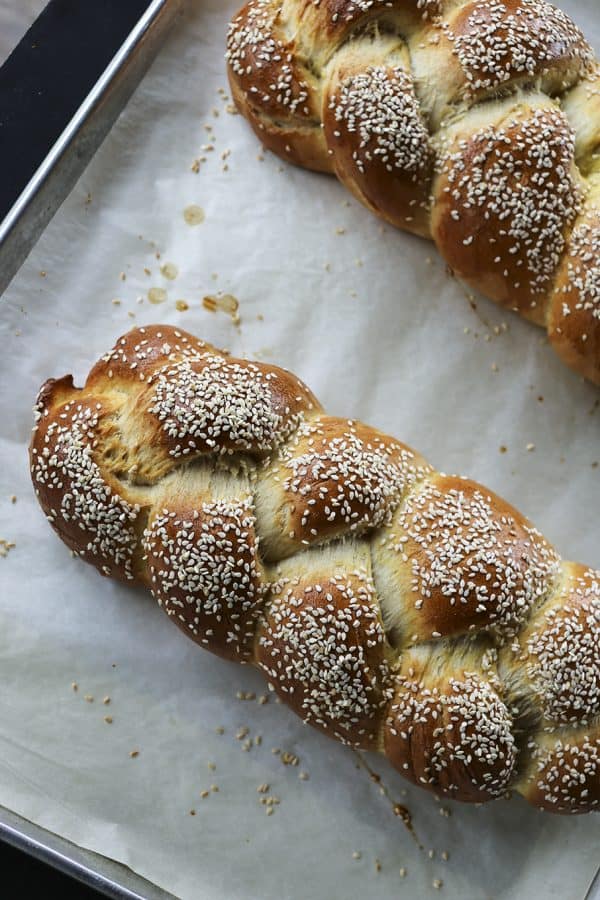
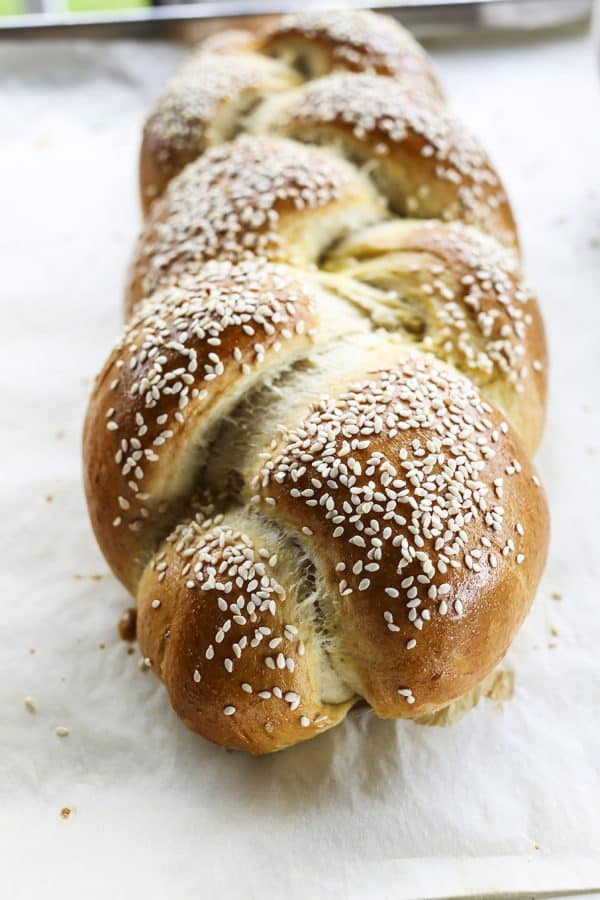
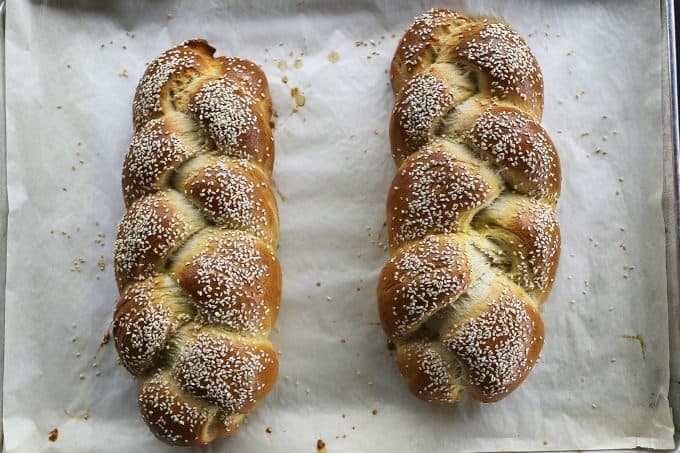
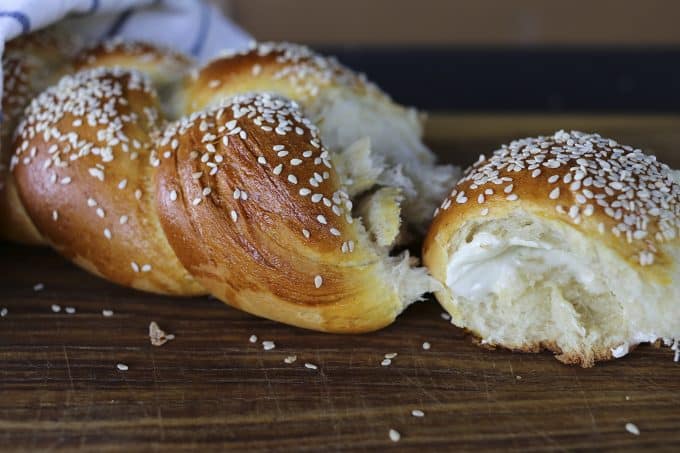










Reader's Thoughts...
Susan says
Absolutely loved this bread and it was so easy to make. I used 2 c all purpose and 2 c whole wheat flour, as well as the required amount of semolina. I used chia seeds and hemp heart seeds on top of one loaf and added some rosemary to that on the second loaf. My hubby described this as almost pretzel like.
I will make this again.
Rebecca says
I’m so glad you loved it, Susan. Thanks for taking the time to rate the recipe. I appreciate it.
Carolyn Brodersen says
REALLY love this–both the recipe and the extensive photos–and I get rave reviews when I make it. Thank you so much!
Rebecca says
You’re very welcome, Carolyn! Thank you for taking the time to rate the recipe and let me know. 🙂
TIna says
After I form it into loaves can I refrigerate and bake the next day?
Rebecca says
Hi Tina- I would not… This one has enough yeast that I’m not sure a long, slow ferment in the fridge is the best idea.
Ashleigh says
Hi,
So you do not recommend letting it slow rise in the fridge or you mean only once its shaped? I am trying to figure out solutions how i can make a few but only can bake one at a time…
Rebecca says
Hi Ashleigh- I hear you, but you might be better to do them in batches. Once you pop it in the fridge, you’ll need to bring it back to room temp and allow it to get puffy for a while (a time frame i can’t predict because of a variety of factors). It is such an easy dough, my recommendation if you can only bake a little at a time is to have staggered batches of dough started.
Lotte says
Wonderful bread recipe! At first, the dough seemed way too dry, even after I added an extra tablespoon of water. But I decided to let it be rather than trying to add more. I’m so glad I did. After resting and then kneading, it came together into a very nice, smooth, pliable dough. It was warm, so it didn’t need the full two hours to proof. Very easy to work with while braiding, and it baked up into nice, crusty loaves of bread. I’ll definitely be using this recipe again
Rebecca says
I’m so glad you loved it, Lotte! It’s a dough that quietly, and slowly hydrates vs. one that looks smooth and elastic right away. I’m glad you took the time!!!
Janine DelGiorno says
What if I can’t vent the oven? I have twin 2 yo toddlers and they do not listen well enough to leave a hot oven open. Any suggestions?
Rebecca says
In that case, I definitely recommend putting it up on a cooling rack outside of the oven! It isn’t worth burning little fingers!
Olga Dziubaniwsky says
Curious – what is the purpose of making the indentation along the length of the dough ropes?
Rebecca says
It’s not exactly crucial, but it helps you to form a more even rope. It’s really an aesthetics thing. It does contribute a bit to overall even cooking, but not enough to worry about if you don’t choose to do it. 🙂
Olga Dziubaniwsky says
Curious – what is the purose of making the indentation along the length of the dough ropes?
Vinny Boombatz says
Hi, bread looks beautiful and reminds of the bread I used to get on Long Island at Iavornne Brothers. Anyway I’ve made it twice and followed the instructions exactly. I proofed it in the oven with hot water underneath to raise oven temp to high 70’s – 80’s. After the first proof the dough comes out wet and the only say I can work with it for form the ropes is by using additional flour. From the video it looks like the roads should be drier and easy to work with. After formed and proofed second time I brush on the egg and sesame seeds. I put it in the oven and it looks ok after baking, but I don’t see any separation of texture among the braids….its all one common loaf inside.
Can you provide me any tips on how I might be more successful making this beautiful bread? thanks in advance.
vinny boombatz says
ropes NOT roads
Rebecca says
Hi Vinny- Let’s see if we can trouble shoot this for you. Is your dough very slack and wet before the first proof? Are you covering the pan before putting it into the oven with the pan of hot water?
Vinny says
Thanks Rebecca. I use mixer with dough hook 8 mins. Pretty much a ball when it’s done. I cover mixing bowl with towel and put it in oven. On a rack below I put a Pyrex pan with hot steamy water on a lower rack and closed door with temp inside oven raising to 88 degrees and dropping to 78 in 2 hrs. Then I take it out to make the loaves. Very hard to work with the dough. Very wet and hard to roll with out adding flour.
Rebecca says
Okay, Vinny- Is it a cohesive ball that pulls away from the sides of the bowl and doesn’t adhere at all? If it is, I suspect the issue may be in your super-proofing in that hot an oven. I think the combination of the super hot temp (I like this bread best when proved a solid 15 degrees cooler than your starting temp) and the steam environment. I have never had my dough go from being cohesive to slack, and that is the only thing I can think of that’s doing this to your project.
Vinny says
Thanks Rebecca. I will try proofing without the steam. Thanks for your help and advice!
Gina says
Ok, otherwise very bland.
Roni Jordan says
I have made this bread so many times I cannot count. Two loaves just out of the oven. I bake for 22 minutes on convect and take them out right away to cool. We call this Italian challah.
Rebecca says
I’m so glad you love it, Roni! Thank you so much for taking the time to rate the recipe, too!
Roni Jordan says
I have made tis bread so many times I cannot count. Two loabes just out of the oven. I bake for 22 minutes on convect and take them out right away to cool. We call this Italian cahallah.
Karen says
When I was a kid my dad would take me to an italian deli where we would buy olives and the most wonderful rolls, and I was never able to duplicate that texture in my homemade bread. This recipe with semolina was exactly what I was looking for. I have to say I was a little concerned with the recipe when I saw how dense this dough was, and it was a workout to knead, but it turned into the most beautiful, soft, chewy delight. Thank you for sharing
Rebecca says
Thank you so much, Karen! I’m so glad that it helped you find the way to feed that food memory!! And thank you, too, for taking the time to rate the recipe. I do appreciate it!
Jodie says
Hello, could you use strong bread flour instead of all purpose?
Many Thanks
Rebecca says
Hi Jodie- You most certainly can, but I’d advise some extra kneading because of the higher protein count!
Nancy says
I’m in process of mKING this bread now. The dough is very dry and heavy. I used the weight measurements. It was not glossy. It’s rising now. Hope it works out.
Rebecca says
Without being there, it’s hard to know what happened. I hope your bread turned out nicely! Do you know what altitude you’re at? Was it humid/dry where you are? What’s your ambient room temperature?
Rebecca says
Hey Nancy- How did this end up for you? I’m so curious about what went wrong for you.
Nicole says
I made this today for Christmas Eve dinner. It was so easy to make and smells delicious. Can’t wait to try it!
Roni Jordan says
Made these today using Bobs Red Mill Artisan Bread Flour and Semil is flour. Superb breads, love having this now in my repertoire. Great tip on making the dough snakes for braiding – will use this the next time I bake challah.
Roni Jordan says
sorry for ty[po – couldn’t correct. Meant to say Semolina flour.
Steven Spungen says
I am a novice baker. What does the indentation do and why is it necessary before you roll the individual pieces before braiding? Thanks!
Rebecca says
That’s a great question, Steven! The purpose of the indentation is to give you a more uniform piece of dough to shape and roll. It makes the ropes for the braid more even when you roll them out.
Isaac says
Look awesome. Will try to bake this weekend.
Stephanie says
This bread is incredible. Made it last weekend, making it again this weekend. Easy and so delicious. Thank you!!
Kathryn says
This turned out great! And I’m not even a great bread braider. I kinda winged it and it still turned out!
Rebecca says
Go, Kathryn!! 😀